Abstract
Underground obstacle detection is the premise of unmanned driving. Aiming at the problem of obstacle detection in coal mines using a millimeter-wave radar, this paper proposes a filtering algorithm for invalid targets in roadways. Firstly, the target information output by millimeter-wave radar is analyzed, and the obstacle information of the underground roadway is extracted. Then, the filter algorithm is used to filter the resolved empty targets, false targets and non-potentially dangerous targets. The empty target whose target distance is zero in radar data is filtered directly. The pseudo targets generated by the radar performance or the instability of the echo signal are filtered through the radar-effective target life cycle method. The non-threatening targets beyond the horizontal range threshold and longitudinal range threshold are filtered directly. The experimental results show that the average filtering rate of the algorithm is more than 87.82% in the static state. When the speed is 5 km/h, the average filter rate is 87.70% for smooth driving and 86.83% for uneven road surfaces. When the speed is 7 km/h, the smooth driving rate is 87.54%, and the uneven road surface is 86.56%. When the speed is 10 km/h, the smooth driving rate is 86.50%, and the uneven road surface is 86.44%. Although the filter rate decreases with the increase of speed or vehicle vibration in the running state, the average filter rate of the proposed algorithm can reach more than 86% under all conditions.
1. Introduction
Intelligent transportation to and from coal mines is one of the important links in the development of intelligent mines [1]. As one of the main auxiliary equipment of coal mine transportation, underground roadway rail-electric locomotive is responsible for transporting personnel, materials, gangue and related working equipment [2]. Up to now, mine electric locomotives still rely on manual driving [3]. However, the bad roadway environment and drivers’ uncertainty lead to frequent transportation accidents of mine electric locomotives [4]. Developing the driverless mine electric locomotive can reduce the number of underground coal mine operators, improve the safety of coal mine production and operation, and has huge economic and social benefits. At present, a few coal mines in China have realized the autonomous driving of electric locomotives through remote monitoring and intelligent scheduling, but the locomotives themselves do not have the ability of autonomous perception and control, and the true sense of autonomous driving has not been realized. The obstacles in coal mines are an important factor affecting the safe running and operation of the unmanned electric locomotive, and the detection of the obstacle is the primary condition for realizing autonomous driving. Current obstacle detection studies mainly include single-sensor detection and multi-sensor fusion detection [5]. At present, the multi-sensor fusion algorithm is mainly based on image fusion of millimeter-wave point clouds or laser point clouds. Due to the imperfect obstacle data set in underground coal mines, the fusion model cannot be fully trained, and the detection effect is reduced [6].
Single-sensor detection technology mainly includes radar, infrared cameras, and vision. Infrared cameras have some shortcomings, such as low resolution and short detection ranges. Visual detection technology can obtain obstacle information in a more comprehensive way [7,8,9]. The YOLOv4-Tiny-4S algorithm can accurately detect and identify all kinds of targets in the image, with an average detection accuracy of 95.35% and an average detection accuracy of 86.69% for small target “gravel” [10]. Meanwhile, the price is relatively low. However, the camera has the disadvantages of being greatly affected by illumination and dust and low reliability, and its real-time performance is limited by the computing power of airborne equipment [11]. Radar obstacle detection sensors are divided into lidar and millimeter-wave radar. Lidar sensors are commonly used in the field of urban road autonomous driving. They have a long detection range, weak interference from active signals and high accuracy, but they are affected by dust, high price and large size. Compared with lidar and vision, millimeter-wave radar has the characteristics of high reliability and active measurement under bad weather and unpredictable lighting conditions [12].
Most of the coal reserves in the world are underground, and more than 95% of coal mines in our country are well-mining mines with average depths of more than 500 m, whose operating environment has obvious particularity. The underground environment of coal mines is rich in dust and gas. Dust mainly comes from various coal dust and rock dust produced by road header mining rock, processing, transportation and charging. The total dust concentration can reach 500~600 mg/m3 [13,14], and the gas produced by coal mining is prone to ignition and explosion. The underground environment of coal mines with high dust and gas requires that the sensor must be inherently safe and explosion-proof and have certain penetration. The underground environment of coal mines is high temperature and humidity, affected by the geothermal effect, heat dissipation of the human body and mechanical and electrical equipment. Sometimes the air temperature is 35 °C high, and the relative humidity is close to 100% [15]. Therefore, in the underground environment of coal mines, the sensor needs to overcome the problems that are not found in the above-ground environment, such as dust, high temperatures, high air humidity, strong noise, strong vibration, strong airflow, and complex electromagnetic environments. Robots using millimeter-wave radar can be used in a large amount of dust, gas and other dangerous gases and the lack of a light, clear and externally-positioned environment to carry out rescue operations. The literature [16,17] shows the good performance of millimeter-wave radar in the mining environment of heavy dust clouds (zero visibility). The underground environment of coal mines is dusty, extremely dark, and the air humidity is high. Compared with millimeter-wave radar, lidar has a higher resolution, but its detection range and accuracy are seriously decreased in harsh environments [18]. On the contrary, millimeter-wave radar has strong penetration, good robustness, and all-weather sensing ability. Millimeter-wave radar is cheap [19] and better suited for underground use in coal mines. The use of millimeter-wave radar can effectively improve the reliability, robustness and accuracy of detection, but there are a large number of invalid targets, such as empty targets, false targets and non-threatening targets, in the original data output of millimeter-wave radar, which will reduce the accuracy of obstacle detection [20].
To address the problem of a large number of invalid targets in the millimeter-wave radar output data, this paper proposes a filtered millimeter-wave radar underground electric locomotive obstacle detection method. By parsing the millimeter-wave radar target information, the null target, false target and non-threatening target data are detected and filtered out using an invalid target filtering algorithm to improve the accuracy of millimeter-wave radar obstacle detection.
This paper will be divided into four parts to illustrate the research on the detection method of roadway obstacles based on invalid target filtering by millimeter-wave radar. The first part introduces the background and the deficiency of related research and the problems to be solved in this paper in the introduction. The second part discusses the basic theory, experimental equipment and research methods. In the third part, experiments and results are analyzed. In the last part, our research findings are summarized and compared with relevant studies, and the research is evaluated. Through the detailed elaboration of these four parts, we believe that readers can have a deeper understanding of the whole process and conclusion of our research.
2. Materials and Methods
2.1. Software, Hardware, and Information Acquisition
The radar sensor used in this study is the ARS 408-21XX from German company Continental A.D.C. GmbH, Memmingen, Germany. It operates at a frequency of 77 GHz and can detect multiple stationary and moving targets with relative velocities ranging from −400 to 200 km/h. It provides a long detection range of up to 250 m and can measure up to 256 moving targets with high reliability and small size, making it suitable for deployment on electric locomotives. The main performance parameters of the millimeter-wave radar are shown in Table 1. Its measurement performance shows that its operating temperature range is −40 °C to +85 °C, it conforms to IP 6k 9k (dust and high-pressure washing) IP 6k7 (underwater 10 cm), Ice water impact test, salt spray resistance, gas mixture EN60068-2-60, able to work in harsh environment. The sensor communicates with the host computer via CAN bus and outputs filtered target information. The hardware and software setup includes an Ubuntu 16.04LTS operating system with ROS, an Intel Core i7-8700k CPU, the ARS 408-21XX radar sensor, a vehicle, a CAN analyzer from Chinaray Technologies (Linux version), and a 12V-5A DC power supply from ADAPTER.

Table 1.
Parameters of ARS 408-21XX millimeter-wave radar.
2.2. Theoretical Framework
2.2.1. Principle of Millimeter-Wave Radar Target Detection
The millimeter-wave radar used in this study adopts FMCW (frequency-modulated continuous wave) technology, which can measure both distance and speed and has obvious advantages in short-range measurement [21,22]. The radar transmit signal is a solid blue line, the radar received signal of a moving target is a red dashed line, the signal of a stationary target is a yellow dashed line, is half of the sweep period, is the sweep bandwidth, and is the time elapsed from the transmission of the signal to the reception of the return wave.
Let and be the frequency variation functions of the transmitted signal and the echo signal, respectively, then the frequency of the differential signal is
Based on the geometric relationships in Figure 1, using the similarity triangle theorem, it follows that:
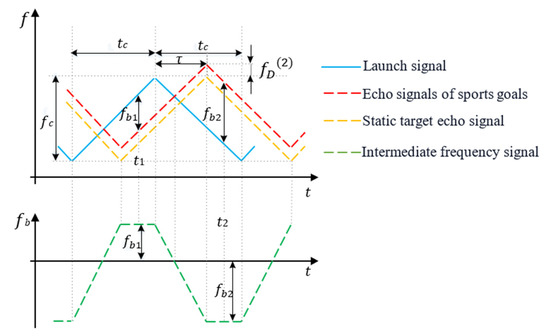
Figure 1.
Principle of millimeter-wave radar ranging.
The relative distance R is calculated as
where —electromagnetic wave propagation speed in free space, about 3 × 108 m/s.
The relationship between the relative distance and the frequency of the differential signal can be obtained from Equations (2) and (3):
The relative distance of the target is proportional to the frequency of the differential signal. Therefore, the relative distance of the target can be determined by measuring the frequency of the differential frequency signal. When there is relative motion between the target obstacle and the radar, the Doppler effect occurs, and the frequency of the reflected signal when the relative motion occurs is the Doppler frequency [23]. The Doppler frequency is calculated as
The and in Figure 1 are the difference frequency functions obtained when the sent signal and the received signal are at the rising and falling edges, respectively, and the difference frequency functions at this time can be found by combining with Equations (4) and (5)
The following equations can be solved to obtain specific values for both and .
When measuring the relative distance and speed of multiple targets, the frequency of the transmitted signal needs to be processed using a moving target detection technique [24]. By varying the sweep bandwidth of the later period, two common solutions for signals emitted at different sweep bandwidths will be obtained, thus determining the relative distances and speeds of multiple targets.
2.2.2. CAN Message
The CAN (Controller Area Network) is a high-speed serial bus technology for communication, which is suitable for high-speed real-time data transmission and remote sensor applications. The CAN Bus has the characteristics of high reliability, real-time, long communication distance and fast data transmission speed, and has been widely used in industrial control, automotive electronics, mechatronics and other fields. In this study, the millimeter-wave radar of ARS 408-21XX outputs the target-related data detected by the CAN message. CAN message is a standard message transmission protocol, which consists of 4 parts: frame header, ID (identifier), data and parity code. The frame header is the first byte of the standard width on the CAN bus and usually includes the physical characteristics of the cable connected to the signal line. ID is an identifier that uniquely identifies a specific node on the CAN bus. Data is the actual data on the CAN bus, which can contain one or more data bytes. The specific amount is determined by different applications. The check code is used to check whether the CAN message is transmitted and received correctly and by comparing the checksum calculus to figure out whether the original data is incorrect. In the target output mode of ARS 408-21XX millimeter-wave radar, the data in the CAN message is expressed in the form of hexadecimal, which needs to be analyzed according to the given communication protocol in order to get the intuitive information of the target. Therefore, you need to understand specific communication protocols when parsing CAN packets to correctly identify data, parse data formats, calculate data values, and convert data into readable target information.
2.3. Target Model
In order to reduce the complexity and ensure real-time detection and identification, the target output mode of the ARS 408-21XX millimeter-wave radar is used, i.e., after a scan (60 ms), the data about the detected target is output in the form of a CAN message, which is in hexadecimal and needs to be parsed according to the given communication protocol to obtain visual information about the target. The data in the CAN message is hexadecimal and needs to be parsed according to the given communication protocol to obtain visual information about the target, as shown in Figure 2.
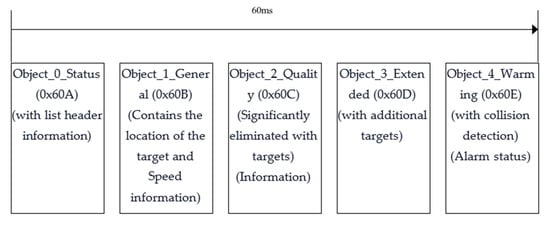
Figure 2.
Format of CAN message and specific information.
The object of this study is an obstacle in the underground tunnel, and it is necessary to obtain information on the orientation, velocity, reflected cross-sectional area and direction of movement of the target obstacle in the underground tunnel, which is contained in the Object_1_General and Object_3_Extended message segments.
2.3.1. Object_1_General Message Segment
Object_1_General contains Object_ID, Object_DistLong, Object_DistLat, Object_VrelLong, Object_DynProp, Object_VrelLat, Object_RCS, as shown in Table 2. Object_ID describes the object ID, which remains constant once the object is detected; Object_DistLong describes the longitudinal distance; Object_DistLat describes the lateral distance; Object_VrelLong describes the longitudinal relative velocity; Object_VrelLat describes the lateral relative velocity; and Object_VrelLat describes the longitudinal relative velocity. VrelLat describes the horizontal relative velocity; Object_DynProp describes the dynamic properties of the object, whether the marker is stationary or in motion; Object_RCS describes the radar scattering cross-section.

Table 2.
Contents in the Object_1_General message segment.
2.3.2. Object_3_Extended Message Segment
Object_3_Extende contains Object_ID, Object_ArelLong, Object_Class, Object_ArelLat, Object_ArelLat, Object_Length, Object_Width, As shown in Table 3. Where, Object_ArelLong describes the longitudinal relative acceleration of the target; Object_ArelLat describes the lateral relative acceleration of the target; Object_Class describes the class of the target; Object_OrientationAngel describes the target’s azimuth; Object_Length describes the length of the target; Object_Width describes the width of the target.

Table 3.
Message contents for Object_3_Extended.
2.4. Filtering Methods for Invalid Millimeter-Wave Radar Targets
In practical conditions, due to noise and vibration in the working environment of underground electric locomotives and the unstable operation of the millimeter-wave radar itself, most of the targets detected by the radar are invalid targets, for only a few are target obstacles. Invalid targets are divided into empty targets, false targets and non-threatening targets, which are filtered out in different ways. Empty targets are easy to filter out and can be judged and filtered out directly based on the distance value of the target measured by the millimeter-wave radar; based on experience, a horizontal and vertical distance threshold is set and the horizontal and vertical coordinates of the non-threat target are compared to the threshold and filtered out if their absolute value is greater than the threshold. A thread is created to combine the results of successive radar frames and set a threshold to filter out false targets using the valid target lifecycle method. The valid target lifecycle method is divided into three phases: generation, persistence and extinction (as shown in Table 4). The status parameter FindCount describes the number of times the target has been detected, and the status parameter LostCount describes the number of times the target has been continuously lost.

Table 4.
Effective radar target life cycle.
The reasons for the loss of millimeter-wave radar targets are: ➀ random bumps and oscillations during the exercise of the mine tramway locomotive, the millimeter-wave radar measurement signal may be lost for a short period of time; ➁ the presence of sloping lanes in the tunnel and uneven terrain may lead to abnormal millimeter-wave radar detection and may even temporarily lose the original valid target; ➂ the original valid target is temporarily blocked by the presence of a temporary target; and ➃ the original valid target has left the set target screening area. The cumulative count threshold CD and the lost count threshold CL can be obtained experimentally. In this paper, the thresholds CD and CL are set to three and five, respectively. By setting the valid lifecycle of a target detected by the radar, false filtering of valid targets can be prevented. For non-threat targets, a suitable target area is selected according to the actual application scenario, and judgment is made based on whether the target is in the target area or not. In this study, the motor truck is used as the research object and the operating area where the underground electric locomotive is located, and the adjacent areas that can pose a danger are selected as the target area. The millimeter-wave radar is mounted in the middle of the mine tramway locomotive, and the intersection of the millimeter-wave radar vertically downwards and horizontally on the ground is taken as the origin of the coordinate system, assuming that the x-axis of the coordinate system is the direction of travel of underground electric locomotive and the y-axis is perpendicular to the longitudinal direction of mine tramway locomotive. A total of four obstacles are assumed to exist in the area of operation of underground electric locomotives and the adjacent area, as shown in Figure 3.

Figure 3.
Working area of electric locomotive.
For an obstacle target within the travel area I on a motor vehicle track to be hazardous, this is measured by a set longitudinal distance threshold. Let be lateral, and the longitudinal coordinates x of the non-threatening target need to satisfy the following conditions:
The threat of targets in the adjacent areas II and III of the trackside danger zone can be measured by setting the lateral coordinates y of non-threatening targets by means of a lateral distance threshold. Let Y0 be the lateral:
The test was conducted with a car instead of a motor car, using a roadway on the ground to simulate a coal mine underground mine tramway locomotive; the car size was 1800 mm × 1000 mm × 1500 mm, and the driving route of the motor car was relatively simple, for track driving, so the transverse threshold Y0 was set to 2 m. The ARS 408-21XX millimeter-wave radar can detect obstacles up to 250 m, and the most underground locomotive operation speed is generally low, about 10 km/h. The longitudinal distance threshold is set to 100 m, which is sufficient for the locomotive to avoid obstacles and other operations, taking into account the 5% measurement error of the radar. Based on the above invalid target filtering method, this paper designs the invalid target filtering algorithm flow, as shown in Figure 4.
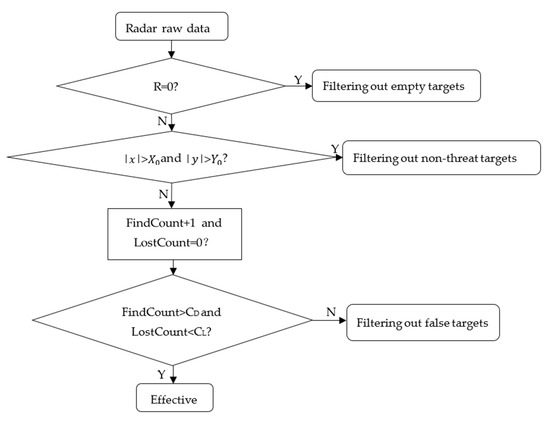
Figure 4.
Filtering process.
The algorithm processes the data collected by radar, directly filters the empty target whose distance is zero in the radar data, and directly filters the non-threatening target whose distance exceeds the transverse range threshold Y0 and the longitudinal range threshold , and filters the false target generated by the radar performance or the instability of the echo signal through the radar-effective target life cycle method. Finally, output the valid target.
3. Test and Result Analysis
3.1. Performance Test of Filtering Algorithm for Invalid Targets
The installation of the ARS 408-21XX millimeter-wave radar should not only reduce the invalid targets caused by the low installation position that is susceptible to orbital interference but also consider the adjustment of the radar’s pitch angle during the debugging phase. Therefore, the three-dimensional universal joint is first installed in front of the vehicle, the acrylic plate is then installed on it, and finally, the millimeter-wave radar is fixed on the acrylic plate through bolts. The installation position is about 520 mm from the ground, which meets the installation requirements. The actual vehicle installation is shown in Figure 5.
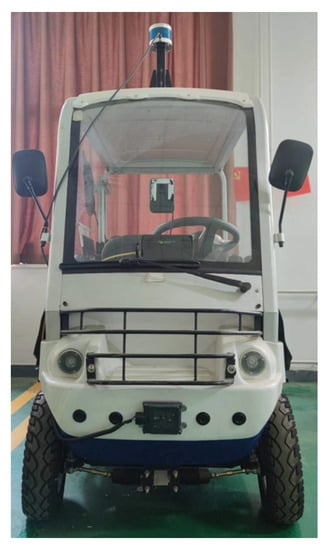
Figure 5.
Installation of ARS 408-21XX millimeter-wave radar in a tractor.
In order to verify the effectiveness of the invalid target filtering algorithm during the driving process of the radar in the alleyway and the invalid target filtering effect caused by the vibration of the vehicle itself, the test was divided into three parts: the car was at a standstill, in a smooth driving state and in the vibration state of the speed bump driving. The test environment is shown in Figure 6, where the obstacles are experimenter A, trolleys and experimenter B. The one in black is Experimenter A, the one in gray is Experimenter B, and the blue car is the cart.
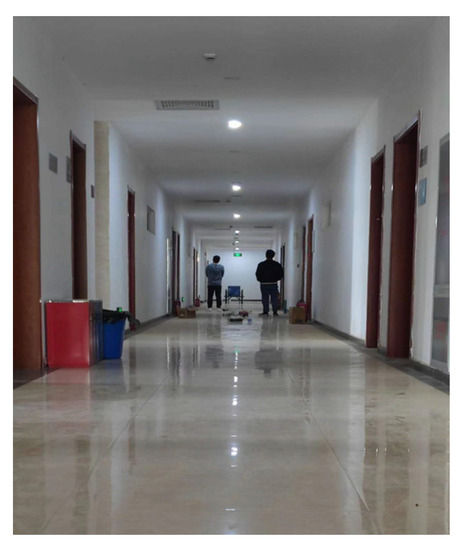
Figure 6.
Experimental environment.
3.1.1. Car at a Standstill
For the test, the car was parked at a distance of approx. 100 m from the obstacle. The ARS 408-21XX millimeter-wave radar data was received using a PC and CAN-USB device, and the messages were read using can-utils. Some of the data received at a standstill is shown in Table 5.

Table 5.
Unfiltered partially-resolved data of millimeter-wave radar at static state.
The unfiltered resolution data of the millimeter-wave radar includes a large number of empty targets, spurious targets and non-threatening targets. For empty targets, target IDs with X = 0 or Y = 0 are filtered out in the algorithm based on the horizontal and vertical coordinates of the target; for spurious targets, the cumulative number of detected targets CD is set to three, and the number of lost targets CL is set to five in the algorithm based on the effective life cycle of the radar; for non-threatening targets, a threshold of horizontal and vertical coordinates is set to filter them out. When the vehicle is at a standstill, a person in the test environment moves 1 m, 2 m, and 3 m from the left front to the right rear of the tractor, the vehicle and the trolley position remain unchanged, and the target information is output using the millimeter-wave radar, and then the invalid targets are filtered out using the algorithm. The results before and after processing in the stationary state are shown in Figure 7.
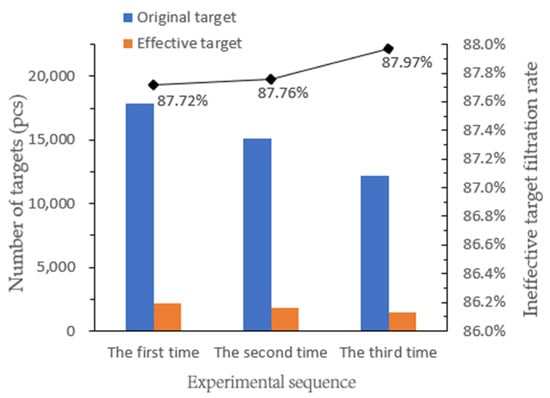
Figure 7.
Before and after processing at res.
The targets in the test environment were processed by the algorithm to obtain valid target information for three types of obstacles: people and trolleys, while the rest of the spurious information was effectively filtered out. After three trials, the average filtering rate of the invalid target filtering algorithm for the radar data applied in this paper was more than 87% in the stationary state.
3.1.2. The Vehicle Was Running in a Straight Line under the Smooth Road Surface
The vehicle was designed to travel at speeds of 5, 7 and 10 km/h, respectively, and as a control variable, the three speeds were tested in the smooth driving state as well. During the tests, the positions of the three obstacles and the angle of the millimeter-wave radar were kept constant, and three tests were conducted at each speed to verify the effect of speed on the filtering effect. The results before and after processing in the driving condition are shown in Figure 8.
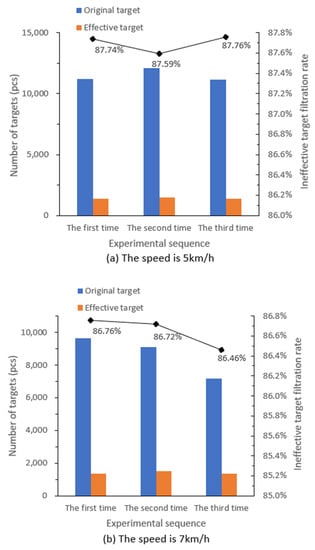
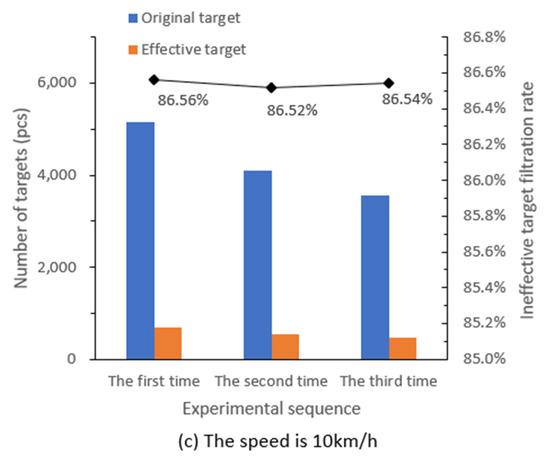
Figure 8.
Before and after processing in motion.
Some pseudo-targets were generated during the driving process due to vehicle vibration and ground inequality. After nine trials, the invalid target filtering algorithm effectively filtered out pseudo targets, empty targets and non-threatening targets, with an average filtering rate of over 86%.
3.1.3. The Vehicle Was Driving on an Uneven Road Surface
Three trials of the rototilling operation were carried out at a set speed to verify the effect of the vehicle vibration operation scenario on the filtering effect while keeping the position of the obstacle and the radar angle constant. The results before and after the treatment in the driving condition of the rotary tillage operation are shown in Figure 9.
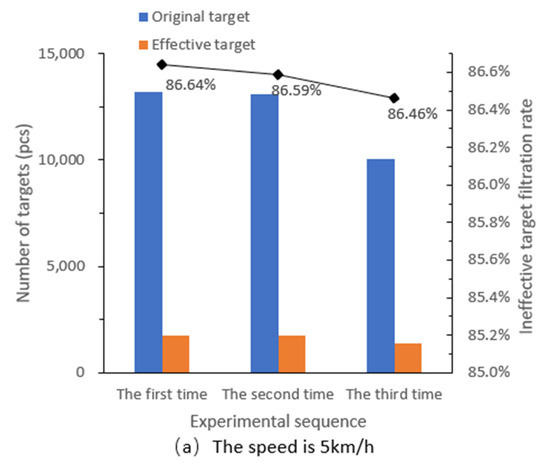
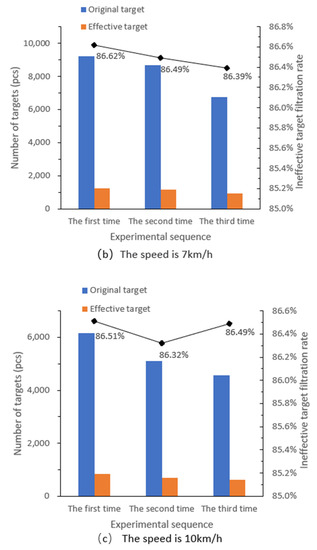
Figure 9.
Results before and after processing in the condition of vibration accompanied by driving.
As the vibration of the vehicle increased, this factor increased the number of false targets. Compared to the steady state, at the same speed, the filtering rate of invalid targets decreases, but after 9 trials, the invalid target filtering algorithm achieves a filtering rate of more than 86% for the 3 types of invalid targets.
3.2. Comparison of the Filtering Rate of Invalid Targets in Different States
In order to visually analyze the filtration effect in different states, the obtained filtration rates and average values are shown in Table 6.

Table 6.
Comparison of invalid target filtering rates.
The experimental results show that the average filtering rate of the algorithm is more than 87.82% in the static state. When the speed is 5 km/h, the average filter rate is 87.70% for smooth driving and 86.83% for uneven road surfaces. When the speed is 7 km/h, the smooth driving rate is 87.54%, and the uneven road surface is 86.56%. When the speed is 10 km/h, the smooth driving rate is 86.50%, and the uneven road surface is 86.44%. Although the filter rate decreases with the increase of speed or vehicle vibration in the running state, the average filter rate of the proposed algorithm can reach more than 86% under all conditions.
With the increase in speed, the filtering effect of the algorithm decreases to a certain extent no matter whether the vehicle is driving in a straight line on a flat road surface or on an uneven road surface because the vibration of the vehicle will be more obvious with the increase of the vehicle speed. This is because as the speed of the vehicle increases, the vibration of the vehicle becomes more obvious. When the vehicle is running in a straight line under the smooth road surface, compared with the uneven road surface, the vibration of the vehicle will be more obvious as the vehicle speed increases. At the same speed, the filter rate decreases because when the vehicle is driving on an uneven road surface, the vibration of the vehicle is also intensified due to the increase of the work done by the motor.
4. Conclusions
Taking millimeter-wave radar as a sensor, a method of filtering and dividing the data generated by millimeter-wave radar to reduce the amount of computation is proposed. After analyzing the target information output by millimeter-wave radar, the target obstacle information in the roadway is extracted, and the invalid target filtering algorithm is developed to detect, judge and filter the data of empty targets, false targets, and non-threat targets after analyzing, so as to improve the obstacle recognition ability of unmanned electric locomotives in coal mines. It provides a further contribution to the application of millimeter-wave radar in underground roadways of coal mines.
Using the car as a platform, three states of tests were conducted: stationary, smooth straight line, and straight line with vibration. The test showed that the algorithm used in this paper could effectively filter out invalid targets, with an average filtering rate of over 87% for stationary state and over 86% for both smooth straight lines and straight lines with vibration.
The average filtering effect of this algorithm is more than 86%. Regarding vision, the YOLOv4-Tiny-4S algorithm can accurately detect and identify all kinds of targets in the image, with an average detection accuracy of 95.35% and an average detection accuracy of 86.69% for small target “gravel.” However, the camera has the disadvantages of being greatly affected by light and dust and low reliability, and its real-time performance is limited by the computing ability of airborne equipment. The underground environment of a coal mine is dusty and dark, vision is greatly affected, and precision cannot be achieved. However, millimeter-wave radar and vision can complement each other well, so it is significant to improve the detection accuracy of millimeter-wave radar. It is hoped that in future work, the computing ability of the on-board equipment can be improved, the obstacle data set in underground coal mine can be perfected, the fusion model can be fully trained, the accuracy of obstacle detection can be improved, and the unmanned driving of electric locomotive in underground coal mine can be realized as soon as possible. Thus, improving the safety of coal mine production operations and providing economic and social benefits.
Author Contributions
Methodology, Y.P.; Software, F.H.; Validation, Z.W. and S.Z.; Formal analysis, Z.G. All authors have read and agreed to the published version of the manuscript.
Funding
This research was funded by the Natural Science Foundation of Hebei Province (E2022402102). This support is greatly acknowledged and appreciated.
Data Availability Statement
The main data is presented in the text, and there is no new data.
Conflicts of Interest
The authors declare that there is no conflict of interest regarding the publication of this article.
References
- Yu, Q.X.; Zhang, Y.S. Track obstacle intelligent recognition technology of mine electric locomotive based on image processing. Metal Mine 2021, 8, 150–157. [Google Scholar]
- Han, J.H.; Wei, X.; Lu, Y.; Wen, Z.; Cheng, Y.A.; Cheng, L. Driverless technology of underground locomotive in coal mine. J. China Coal Soc. 2020, 45, 2104–2115. [Google Scholar]
- Chen, Y.Y.; Huo, Z.L.; Liu, Z.W.; Zhang, Y.H. Development trend and key technology of coal mine transportation robot in China. Coal Sci. Technol. 2020, 48, 233–242. [Google Scholar]
- Chen, X.M.; Wang, E.B.; Wang, G. Research on electric locomotive self-driving technology in coal mine. Coal Sci. Technol. 2020, 48, 159–164. [Google Scholar]
- Liu, M.; Chen, J.; Zhao, X.; Wang, L.; Tian, Y. Dynamic obstacle detection based on multi-sensor information fusion. IFAC Pap. Line 2018, 51, 861–865. [Google Scholar]
- Wang, H.; Xu, Y.S.; Cai, Y.F.; Chen, L. Overview of intelligent vehicle multi-target detection technology based on multi-sensor fusion. J. Automot. Saf. Energy 2021, 12, 440–455. [Google Scholar]
- Guo, Y.C.; Tong, J.L.; Wang, S. Research on multi-object detection in driving scene of underground unmanned electric locomotive. J. Mine Autom. 2022, 48, 56–63. [Google Scholar]
- Wang, J.H.; Wang, L.G.; Bi, L. Obstacle Detection Technology of Mine Electric Locomotive Driverless Based on Computer Vision Technology. Gold Sci. Technol. 2021, 29, 136–146. [Google Scholar]
- Yang, X.; Ma, B.; Wang, J.S.; Zhu, M.Q. Obstacle detection and ranging method of mine locomotive based on monocular vision. Ind. Mine Autom. 2014, 40, 96–99. [Google Scholar]
- Guo, Y.C.; Yang, T.; Wang, S. Research on Multi-Object Real-Time Detection of Mine Electric Locomotive Based on Improved YOLOv4-Tiny. Adv. Eng. Sci. 2023, 1–11. Available online: https://jsuese.ijournals.cn/jsuese_cn/ch/reader/view_abstract.aspx?flag=2&file_no=202201070000003&journal_id=jsuese_cn#:~:text=Firstly%2C%20in%20order%20to%20improve%20the%20detection%20ability,by%20K-means%20and%20K-means%2B%2B%20clustering%20analysis%20algorithms%20respectively (accessed on 26 March 2023).
- Inoue, K.; Kaizu, Y.; Igarashi, S.; Imou, K. The development of autonomous navigation and obstacle avoidance for a robotic mower using machine vision technique. IFAC Pap. Line 2019, 52, 173–177. [Google Scholar] [CrossRef]
- Chen, X.Z.; Liu, R.J.; Zhang, S.; Zeng, H.; Yang, X.; Deng, H. Development of millimeter wave radar imaging and SLAM in underground coal mine environment. J. China Coal 2020, 45, 2182–2192. [Google Scholar]
- Jian, J.; Xie, J.L.; Guo, Y.Y. Analysis of coal mine dust concentration and particle size. J. Taiyuan Univ. Technol. 2017, 48, 592–597. [Google Scholar]
- 3D Object Detection Evaluation. 2017. Available online: http://www.cvlibs.net/datasets/kitti/evalobject.objbenchmark=3d,2020-03-31 (accessed on 26 March 2023).
- Wang, P. Influence of humidity on workers’ physical and mental health in coal mine workplaces. Occup. Health 2018, 34, 872–875. [Google Scholar]
- Widzyk-Capehart, E.; Brooker, G.; Scheding, S.; Hennessy, R.; Maclean, A.; Lobsey, C. Application of millimeter wave radar sensor to environment mapping in surface mining. In Proceedings of the International Conference on Control, Automation, Robotics and Vision, Singapore, 5–8 December 2006; pp. 1–6. [Google Scholar]
- Reina, G.; Underwood, J.; Brooker, G.; Durrant-Whyte, H. Radar-based perception for autonomous outdoor vehicles. J. Field Robot. 2011, 28, 894–913. [Google Scholar] [CrossRef]
- Hargrave, C.; Clarkson, I.V.L.; Lui, H. Radar waypoint navigator for underground mining. In Proceedings of the European Conference on Antennas and Propagation (Eu CAP 2014), The Hague, The Netherlands, 6–11 April 2014; pp. 3587–3591. [Google Scholar]
- He, J.; Terashima, S.; Yamada, H.; Kidera, S. Diffraction signal based human recognition in non-line-of-sight (NLOS) situation for millimeter wave radar. IEEE J. Sel. Top. Appl. Earth Obs. Remote Sens. 2021, 14, 4370–4380. [Google Scholar] [CrossRef]
- Tan, L.F. Research on Forward Vehicle Detection Method by Fusion of Machine Vision and Millimeter Wave Radar; Hunan University: Changsha, China, 2018. [Google Scholar]
- Sun, K.; Wu, K.H.; Wang, Y.T.; Shao, Z.C. Research on millimeter wave radar-based obstacle avoidance system for plant protection UAVs. Transducer Microsyst. Technol. 2020, 39, 73–76. [Google Scholar]
- Song, W.H.; Zhou, B.; Bu, Z.Y.; Zhou, Z.G. Multi-target matching algorithm based on composite FMCW waveform. J. Univ. Chin. Acad. Sci. 2022, 39, 110–118. [Google Scholar]
- Zhao, R.J. Design of differential frequency signal acquisition system based on FMCW radar. Ship Electron. Eng. 2019, 39, 83–85. [Google Scholar]
- Song, J.Q.; Liu, Y.X.; Li, K. Multi-target detection based on trapezoidal wave modulated FMCW radar. Space Electron. Technol. 2018, 15, 12–16. [Google Scholar]
Disclaimer/Publisher’s Note: The statements, opinions and data contained in all publications are solely those of the individual author(s) and contributor(s) and not of MDPI and/or the editor(s). MDPI and/or the editor(s) disclaim responsibility for any injury to people or property resulting from any ideas, methods, instructions or products referred to in the content. |
© 2023 by the authors. Licensee MDPI, Basel, Switzerland. This article is an open access article distributed under the terms and conditions of the Creative Commons Attribution (CC BY) license (https://creativecommons.org/licenses/by/4.0/).